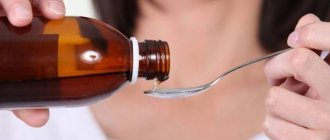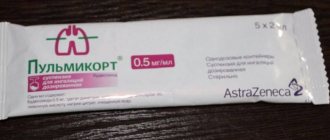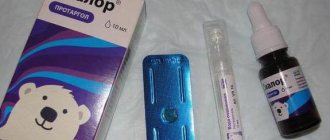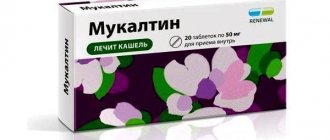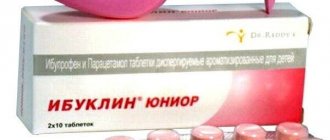Sulfacyl sodium for runny nose for children
Albucid 20% in the form of drops is used to treat ophthalmological diseases and runny nose in children. Typically, Sulfacyl sodium for a runny nose is prescribed by specialists for children under 6 months of age, 1 drop in each nostril 4 times a day for 7 days.
Since this drug can cause a burning sensation, for instillation into the nose of a newborn, a 20% solution must be diluted 1:1 with boiled water. The dosage and duration of treatment with sodium sulfacyl for runny nose in children over one year old is determined by the doctor depending on the condition of the little patient. In order for the drug to achieve its goal, you need to properly prepare the nasal passages before instillation and follow the technology for administering Sulfacyl sodium for the common cold in children. After clearing the nasal cavity of mucus, you need to tilt your head to the side and slightly back or lie on your side.
The drug is injected into the nostril, which is located at the top. After administering the drug, you should immediately turn your head in the opposite direction, while pressing your nostril to the nasal septum and remain in this position for 15-20 seconds. If this is not done, the medicine will flow into the nasopharynx and will not work.
Since Albucid is an antimicrobial drug, it can be used for instillation into the ears, but drops can only be used if there is no purulent inflammation. It is impossible to find out on your own without a professional examination, so only a doctor can determine the severity of the disease and prescribe treatment.
Important
Albucid can be dripped into the ears if the eardrum is not damaged, otherwise inflammation may develop, which will lead to deafness.
Before instilling the drug into the ears, the drops in the bottle must be warmed to body temperature. To do this, just hold the bottle in your palms for several minutes, shaking it periodically. Then you need to wash your hands to avoid infection in your ears. During instillation, you should not touch the surface of the ear with a pipette, and if you use a pipette that does not come from a bottle, then it cannot be used to introduce various medications into the ear canals.
If the doctor has prescribed several instilled drugs for treatment, then at least 15 minutes should pass between their administration. This rule must be followed when using drops in the nose and eyes. Before starting the procedure of instilling sodium sulfacyl into the ears, they must be cleaned of accumulated wax. If this is not done, the drug will not be able to effectively cope with bacteria. It is better to clean your ears with a cotton swab, since in this case there is no danger of damaging the eardrum.
You should absolutely not use cotton swabs to clean children's ears. To instill the drug into the ears, you must lie on your side, so that the sore ear is at the top, and the drug does not flow out after administration. The medicine should get as deep into the ear canal as possible, and not remain on the walls, so it is advisable to carry out the procedure with an assistant. After instilling the medicine, you need to lie in the same position for about 15 minutes. According to the instructions, sodium sulfacyl is intended to combat microbes that multiply in infectious eye diseases.
But for the drug to have an effect, it is important to use it correctly:
- Do not touch the pipette with your hands.
- Before starting the procedure, you need to wash your hands, then you need to tilt your head back, pull down the lower eyelid near the nose and look up. The medicine is injected into the resulting “pocket”, after which the eyelid must be released, the eye closed and the eyelid pressed with a finger. You should remain in this position for 2 minutes so that the drug does not enter the nasal sinus.
- After completing the procedure, the bottle must be closed.
- A bottle with a broken seal after opening can be stored for a maximum of 7 days, after which the drug becomes unsuitable for use as it loses effectiveness.
General information about the medicine
Sulfacyl sodium is, first of all, drops for the treatment of eyes, but some specialists may also prescribe them for rhinitis. The medicine belongs to the group of antibacterial agents. It also helps relieve inflammation, irritation and produces an antiseptic effect.
Indications
Thanks to the active component, the drug can stop the development of streptococcal and staphylococcal infections. The drug is widely used for pneumococcal lesions.
The drug is indicated in the following cases:
- The presence of purulent ulcers on the cornea of the eye.
- Infection of wounds in the area of the visual apparatus.
- Purulent diseases in which the pathological process affects the eyes.
- Conjunctivitis.
Types of conjunctivitis
The active substance is sodium sulfacyl. It is he who negatively affects pathogenic microorganisms. The medicine also contains hydrochloric water and sodium thiosulfate.
The drug has a broad effect and can also be used in the development of diseases of the hearing aid. The product can be instilled into the ears only in cases where there is no purulent discharge. It is impossible to find out about their presence on your own, and consultation with a specialist is required, since purulent masses may not have a way out.
Release forms
For eye pathologies and runny nose, it is used in the form of drops. The active substance content is 20%. The medicine can also be purchased at pharmacies in the form of powder, solution in bottles (5 and 10 ml), ointment, injection solution, powder.

Healthy sinusitis and sinusitis
Before prescribing a drug, the doctor determines the level of sensitivity of pathogenic microorganisms to the active substance. In its absence, the drug will not be effective.
Important! For adults, when using the medicine orally, the daily dose should not exceed 7 grams. A single dose is prescribed in an amount of no more than 2 grams.
When pneumonia, purulent inflammation of the bronchi or trachea is diagnosed, an injection solution is used. It is administered intravenously twice a day. More than 12 hours should pass between injections.
Eye drops are used in cases of infection of the visual apparatus, two drops each. The product is also used to prevent eye pathologies in newborns.
Analogs
Structural analogues of sodium sulfacyl include such drugs as:
- Prontamid.
- Sodium sulfacetamide.
- Sulfacyl soluble.
- Octsetane.
- Albucid OPnevm_1223.
- Ophthalimide.
- Sebizon.
- Sulfaprocul.
- Acetopt.
The attending physician must prescribe the drug and determine the dosage, since improper use causes side effects, deterioration of well-being and the development of complications.
Can I put it in my nose?
The drug is prescribed by pediatricians for instillation into the nose for prolonged runny noses in young children. Some doctors resort to using the drug immediately after detecting a bacterial infection. Since the main purpose of sodium sulfacyl is to fight eye infections, parents often have concerns.
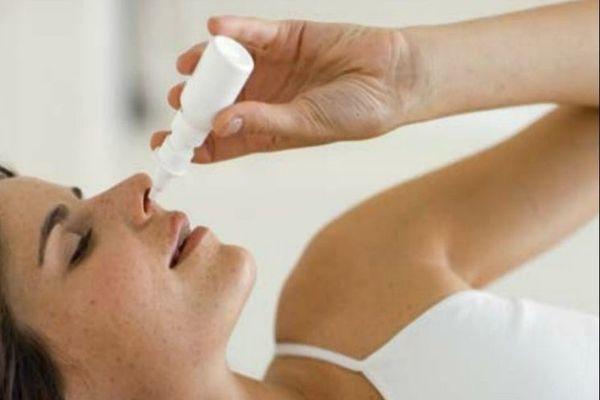
Is it possible to drip this product into the nose? Using the drug in this way is not prohibited. It has a gentle effect on eye tissue. Thanks to this, the product cannot harm the more resistant nasal mucosa. The use of the product is safe regardless of the patient’s age (treatment of children is allowed) and does not lead to damage to the internal tissues of the nasal cavity.
Sodium sulfacyl was created to counteract pathogenic microorganisms. Therefore, it makes sense to use the product only if a runny nose appears due to infection with an infectious disease.
The main sign of this is the presence of white or green discharge. If there is no infection, using eye drops will not work.
How the drug works
The action of the medication is based on stopping the proliferation of bacterial microflora and the ability of children’s bodies to independently cope with the infection. Treatment with the drug requires a strong immune system and a local nature of the infectious process.
In terms of their chemical composition, sulfonamides are the opposite of the acid necessary for bacteria to function. The drops have a slightly alkaline reaction. They disrupt life processes and lead to the death of bacterial microflora, which loses the ability to reproduce and gradually dies.
The drug has a slight drying effect and kills bacteria. Thanks to this, it is possible to reduce inflammation of the eye tissues and nasal sinuses, and facilitate nasal breathing for babies who do not know how to blow their nose. Sodium sulfacyl promotes easier passage of mucus from the nose.
The drug is often prescribed to infants with a runny nose of bacterial etiology.
Indications
In otolaryngology, Albucid is used to eliminate bacterial rhinitis, which is most often impossible to distinguish from viral rhinitis on your own. Therefore, the use of nasal drops is allowed only after visiting a doctor.

For chronic rhinitis caused by colds, adults should instill a 30% solution, children are prescribed a product with a concentration of 20%.
The drug is used in the treatment of runny nose caused by microorganisms sensitive to sulfonamides, and accompanied by thick yellow or green discharge from the nasal cavity.
Possible complications caused by the drug
The drug is safe, and taking it in dosages recommended by the doctor, there are no complications caused by the drug.
An overdose can only occur if it is used for a long time.
Treatment of nasal polyps with folk remedies
Tonsillitis in children - features of the disease and treatment methods are described here.
Prevention of chronic tonsillitis in children //drlor.online/zabolevaniya/gortani-glotki-bronxov/angina/profilaktika-anginy-u-detej.html
How to use to treat baby runny nose
The doctor will prescribe the correct dosage based on information about your disease and the patient’s age. The main points are as follows: you cannot prescribe the drug yourself, use a stitched product or a damaged bottle.
When instilled, quite severe painful symptoms may appear in the form of a burning sensation, which will gradually pass. The big advantage of sulfacyl when instilling drops for children is the absence of a vasoconstrictor effect and is not addictive, which most drugs cannot boast of.
What effective remedy for the common cold is most often used for children over one year old is indicated here.
Infants, dosage
This remedy can be used for children of the first year of life. As eye drops, sodium sulfacyl is used in children immediately after birth to prevent blenorrhea, a complex infectious disease that the baby could “catch” from the mother’s birth canal.
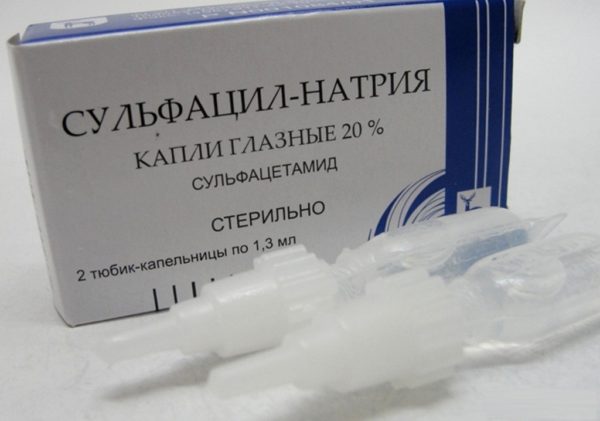
Usually the drug is used before bedtime to make the baby more comfortable.
With a severe runny nose, infants have difficulty breathing, so the use of the drug can significantly alleviate this condition. For a single dose, one drop will be enough; it is recommended to repeat it no more than three times a day.
Which inhaler is the most effective for children is indicated in the article.
Unless otherwise specified, the usual pediatric dosage is 20% sodium sulfacyl solution. If after two days no improvement is noticed, an urgent consultation with a doctor is necessary about the advisability of changing the medication.
Sulfacyl drops for children after one year
Judging by reviews from parents, sodium sulfacyl is often prescribed specifically for the treatment of a runny nose during colds and infectious diseases. The dosage is prescribed by the doctor; you cannot use the drug for more than seven days, if the result is not noticeable in the first days of use, perhaps the infection is not bacterial in nature, so you should change the drug.
Children over one year old are prescribed 1-2 drops three times a day. From the age of six, you can slightly increase the intake to four times a day. Children over 12 years of age and adults can use a 30% sodium sulfacyl solution.
How to treat a runny nose in a 3-year-old child is described in this article.
The big advantage of sodium sulfacyl is its very affordable price, while most drugs with similar effects are much more expensive. Many parents buy this product in advance for their home first aid kit as insurance for unexpected events.
Treatment of children
The drug, despite the fact that it belongs to the group of antibiotics, is a relatively safe drug. It is used not only for diseases of the visual apparatus or inflammation of the nasopharynx in adults. The drug is prescribed for the treatment of children, including infants.
The drug is effective in cases where bacterial rhinitis is established in a child. Thanks to the active component, it is possible to quickly stop a runny nose and make the baby’s breathing easier. The drug is also used when sinusitis is diagnosed in children. The medicine helps to avoid the development of serious consequences.
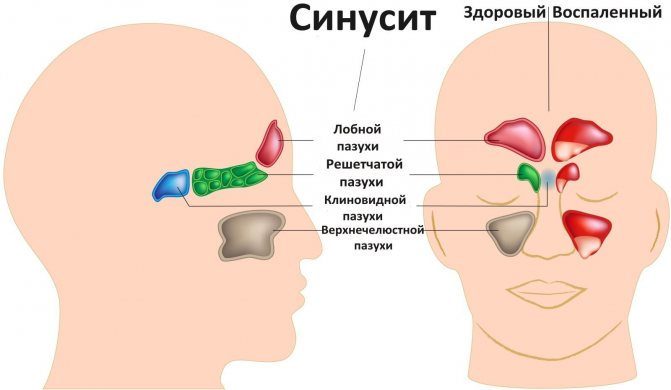
Sinusitis
Before using the product, you should consult with your doctor, since the drug belongs to the group of antibiotics and may cause the development of undesirable consequences.
Parents should remember that it is prohibited to use the medicine without a specialist’s prescription. There is also no need to use a drug that has expired.
After instillation, the baby may experience unpleasant sensations that are not associated with another disease. Most often, the child complains of itching and burning. They gradually go away on their own. But in cases where the unpleasant symptoms are intense, you should rinse your nose and consult a doctor.
Infants
Sulfacyl sodium is often used in pediatrics to prevent the development of blenorrhea after childbirth. This is an infectious disease that occurs when bacteria penetrate the mucous membranes during the passage of a child through the birth canal.
The medicine also helps relieve nasal breathing during a runny nose. For infants, nasal congestion makes breathing difficult. To improve your well-being, it is recommended to instill one drop three times a day into each nostril. Usually the procedure is carried out before bedtime so that the baby can get enough sleep.
The medicine may cause burning and itching. That is why it is recommended to dilute the drug with boiled water in a 1:1 ratio. The dosage is determined by the attending physician depending on the presence of indications, contraindications and the individual characteristics of the child’s body.
Before instilling the product, the nasal passages should be prepared. This will help the medicine reach the site of the pathological process. Then the child’s head should be tilted slightly to the side and the nose should be dripped.
